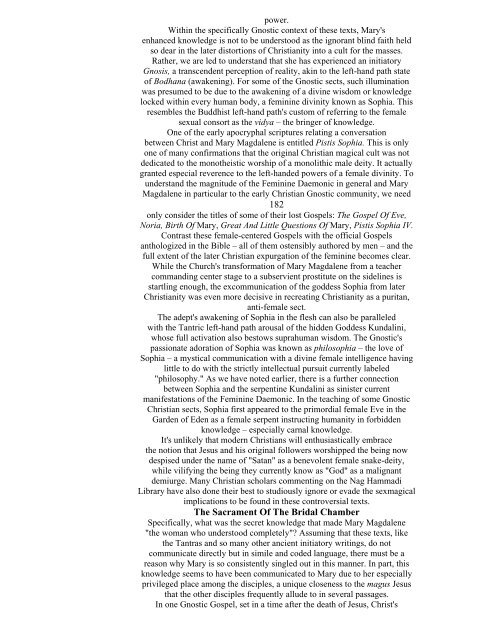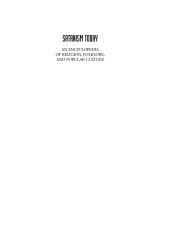I. VAMA MARGA Foundations Of The Left-Hand Path - staticfly.net
I. VAMA MARGA Foundations Of The Left-Hand Path - staticfly.net
I. VAMA MARGA Foundations Of The Left-Hand Path - staticfly.net
Create successful ePaper yourself
Turn your PDF publications into a flip-book with our unique Google optimized e-Paper software.
power.<br />
Within the specifically Gnostic context of these texts, Mary's<br />
enhanced knowledge is not to be understood as the ignorant blind faith held<br />
so dear in the later distortions of Christianity into a cult for the masses.<br />
Rather, we are led to understand that she has experienced an initiatory<br />
Gnosis, a transcendent perception of reality, akin to the left-hand path state<br />
of Bodhana (awakening). For some of the Gnostic sects, such illumination<br />
was presumed to be due to the awakening of a divine wisdom or knowledge<br />
locked within every human body, a feminine divinity known as Sophia. This<br />
resembles the Buddhist left-hand path's custom of referring to the female<br />
sexual consort as the vidya – the bringer of knowledge.<br />
One of the early apocryphal scriptures relating a conversation<br />
between Christ and Mary Magdalene is entitled Pistis Sophia. This is only<br />
one of many confirmations that the original Christian magical cult was not<br />
dedicated to the monotheistic worship of a monolithic male deity. It actually<br />
granted especial reverence to the left-handed powers of a female divinity. To<br />
understand the magnitude of the Feminine Daemonic in general and Mary<br />
Magdalene in particular to the early Christian Gnostic community, we need<br />
182<br />
only consider the titles of some of their lost Gospels: <strong>The</strong> Gospel <strong>Of</strong> Eve,<br />
Noria, Birth <strong>Of</strong> Mary, Great And Little Questions <strong>Of</strong> Mary, Pistis Sophia IV.<br />
Contrast these female-centered Gospels with the official Gospels<br />
anthologized in the Bible – all of them ostensibly authored by men – and the<br />
full extent of the later Christian expurgation of the feminine becomes clear.<br />
While the Church's transformation of Mary Magdalene from a teacher<br />
commanding center stage to a subservient prostitute on the sidelines is<br />
startling enough, the excommunication of the goddess Sophia from later<br />
Christianity was even more decisive in recreating Christianity as a puritan,<br />
anti-female sect.<br />
<strong>The</strong> adept's awakening of Sophia in the flesh can also be paralleled<br />
with the Tantric left-hand path arousal of the hidden Goddess Kundalini,<br />
whose full activation also bestows suprahuman wisdom. <strong>The</strong> Gnostic's<br />
passionate adoration of Sophia was known as philosophia – the love of<br />
Sophia – a mystical communication with a divine female intelligence having<br />
little to do with the strictly intellectual pursuit currently labeled<br />
"philosophy." As we have noted earlier, there is a further connection<br />
between Sophia and the serpentine Kundalini as sinister current<br />
manifestations of the Feminine Daemonic. In the teaching of some Gnostic<br />
Christian sects, Sophia first appeared to the primordial female Eve in the<br />
Garden of Eden as a female serpent instructing humanity in forbidden<br />
knowledge – especially carnal knowledge.<br />
It's unlikely that modern Christians will enthusiastically embrace<br />
the notion that Jesus and his original followers worshipped the being now<br />
despised under the name of "Satan" as a benevolent female snake-deity,<br />
while vilifying the being they currently know as "God" as a malignant<br />
demiurge. Many Christian scholars commenting on the Nag Hammadi<br />
Library have also done their best to studiously ignore or evade the sexmagical<br />
implications to be found in these controversial texts.<br />
<strong>The</strong> Sacrament <strong>Of</strong> <strong>The</strong> Bridal Chamber<br />
Specifically, what was the secret knowledge that made Mary Magdalene<br />
"the woman who understood completely"? Assuming that these texts, like<br />
the Tantras and so many other ancient initiatory writings, do not<br />
communicate directly but in simile and coded language, there must be a<br />
reason why Mary is so consistently singled out in this manner. In part, this<br />
knowledge seems to have been communicated to Mary due to her especially<br />
privileged place among the disciples, a unique closeness to the magus Jesus<br />
that the other disciples frequently allude to in several passages.<br />
In one Gnostic Gospel, set in a time after the death of Jesus, Christ's
















